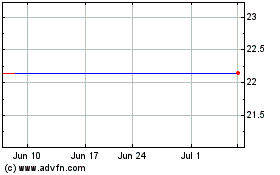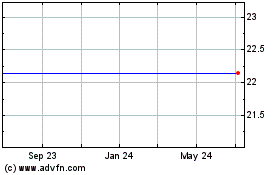Treasury Downgrade Might Chip Away At Banks' Capital - Macquarie
July 28 2011 - 4:46PM
Dow Jones News
A decline in the value of Treasury securities due to a downgrade
in the U.S. credit rating could lower critical capital ratios at
banks large and small.
While declining Treasury prices wouldn't put any major banks in
regulatory intensive care, they would chip away at the cushions
that are a key barometer of bank health. Such sizable banks as Bank
of New York Mellon Corp. (BK) and Bank of America Corp. (BAC)
could, in an extreme case where Treasury prices fall by 10%, have a
key measure of capital decline by about one percentage point and
nearly 0.9 percentage point, respectively, according to a study
Thursday by Macquarie Equity Research.
The average bank holds 10% of its assets in Treasury bonds and
notes and bonds issued by government agencies like Fannie Mae
(FNMA) and Freddie Mac (FMCC), according to Macquarie. The holdings
are sizable because banks like securities commonly believed to be
among the safest investments.
Macquarie gauges in the report how much banks' capital would
decline if bond values fall--and for some banks, it could be an
unpleasant hit. The cost of hedging derivatives and interest-rate
risk could also rise, and revenue in the mortgage business could
fall, the firm said.
The tier 1 common capital ratio of Bank of New York Mellon, for
example, could slip more than a percentage point if the value of
Treasury and other agency securities on its books could decline by
10%, according to Macquarie the worst case scenario.
Tier 1 common capital has become one of the most important
ratios to evaluate a bank's health, and is closely watched by
regulators, even though tier 1 capital is still the benchmark for a
bank to be considered "well capitalized," the critical regulatory
seal of approval. Tier 1 capital includes certain intangible assets
stripped off tier 1 common ratios, and is measured as a percentage
of assets.
Ratings agencies have warned they could strip U.S. government
bonds of their triple A rating if the government can't agree on how
to handle the nation's fiscal deficit. Bonds ratings tied to Fannie
and Freddie could also fall in lock step. It is unclear what impact
a downgrade of such securities might have on their value; the
Macquarie report looked at the effect of market value declines in
U.S. debt bonds of 3%, 6% and 10%.
Bank of America, the nation's largest bank by assets, wouldn't
lose as much of its tier 1 common capital as some other banks if
Treasurys declined. Under Macquarie's worst-case scenario, its tier
1 common ratio could slip 88 basis points to 7.76%.
But some smaller banks Macquarie follows might get hit much
harder. The tier 1 common ratio of CoBiz Financial Corp. (COBZ), a
small regional bank in Denver, would decline 153 basis points, to a
rather thin 4.81% tier 1 common capital ratio. Regulators required
4% tier 1 common in recent stress tests for large banks.
SVB Financial Group (SIVB), a healthy bank focusing on banking
start-ups and their venture capitalists, could see its tier 1
common ratio slip by 336 basis points, to 9.5%--still healthy,
particularly for a bank too small to be considered systemically
important by regulators.
None of the banks mentioned were immediately able to comment on
the impact of a downgrade of Treasurys on their capital ratios.
Macquarie analyst Thomas Alonso considers the numbers in its
report good news for investors. "For the past two years, the
industry has been in capital rebuild mode; there is a whole lot of
capital in the industry," so any hit from falling bond prices
wouldn't hit banks at the worst time, he said.
The impact on derivatives is harder to gauge, but investors
should keep it in mind, Alonso said. Banks don't disclose exactly
how they hedge risk.
The impact on the mortgage business also remains
uncertain--mortgage rates remain at historic lows and will rise
eventually anyway, but an expedited cooling of the mortgage
business by rising rates might hurt fragile housing values, which
could boost banks' losses from defaulting mortgages, Alonso
said.
-By Matthias Rieker, Dow Jones Newswires; 212-416-2471;
matthias.rieker@dowjones.com
Cobiz Financial Inc. (delisted) (NASDAQ:COBZ)
Historical Stock Chart
From May 2024 to Jun 2024

Cobiz Financial Inc. (delisted) (NASDAQ:COBZ)
Historical Stock Chart
From Jun 2023 to Jun 2024
